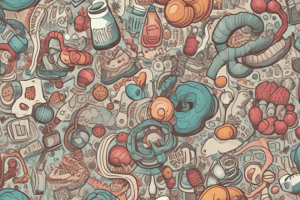Podcast
Questions and Answers
Which of the following carbohydrates is classified as a monosaccharide?
Which of the following carbohydrates is classified as a monosaccharide?
- Maltose
- Glucose (correct)
- Lactose
- Sucrose
What type of bond is formed during the condensation reaction between two monosaccharides?
What type of bond is formed during the condensation reaction between two monosaccharides?
- Peptide bond
- Hydrogen bond
- Ionic bond
- Glycosidic linkage (correct)
Which of the following is NOT a function of polysaccharides?
Which of the following is NOT a function of polysaccharides?
- Cell recognition
- Transport in the bloodstream (correct)
- Energy storage
- Structural support
Which of the following describes the structure of polysaccharides?
Which of the following describes the structure of polysaccharides?
In which of the following forms can monosaccharides exist?
In which of the following forms can monosaccharides exist?
What reaction type breaks down disaccharides into monosaccharides?
What reaction type breaks down disaccharides into monosaccharides?
Which of the following is a characteristic of complex carbohydrates?
Which of the following is a characteristic of complex carbohydrates?
Which of the following statements is true about cellulose?
Which of the following statements is true about cellulose?
Flashcards
Monosaccharides
Monosaccharides
The simplest sugars consisting of a single molecule. Examples include glucose, fructose, and galactose.
Glucose
Glucose
A six-carbon sugar, also known as blood sugar and the primary energy source for many organisms.
Pentose
Pentose
A five-carbon sugar found in nucleic acids (DNA and RNA) and other important biological molecules.
Glycosidic linkage
Glycosidic linkage
Signup and view all the flashcards
Condensation reaction
Condensation reaction
Signup and view all the flashcards
Polysaccharides
Polysaccharides
Signup and view all the flashcards
Starch
Starch
Signup and view all the flashcards
Glycogen
Glycogen
Signup and view all the flashcards
Study Notes
Carbohydrates Overview
- Carbohydrates are one of the most common organic molecules.
- They always contain carbon (C), hydrogen (H), and oxygen (O) in a ratio of (CH₂O)ₙ.
- They are the primary energy source in the body.
- Sugars and starches store energy efficiently for use by the body.
- Carbohydrates contain hydroxyl and carbonyl groups.
- Most carbohydrates are polar molecules that dissolve readily in water.
- Carbohydrates are essential for providing energy to various bodily functions.
Types of Carbohydrates
-
Monosaccharides: Simple sugars (single molecule).
- Examples include glucose, fructose, galactose, ribose, and deoxyribose.
- Glucose is the primary energy source.
- Glucose, fructose, and galactose are all hexoses (6 carbons)
- Ribose and deoxyribose are pentoses (5 carbons)
- Sugars usually end in "-ose".
- Can exist in straight-chain or ring forms.
-
Disaccharides: Double sugars (two monosaccharides bonded together).
- Examples include maltose, sucrose, and lactose.
- Formed through a condensation reaction, releasing a water molecule.
- The bond formed between monosaccharides is called a glycosidic linkage.
- Bonded together through dehydration synthesis.
-
Polysaccharides: Complex carbohydrates (many monosaccharides bonded together).
- Examples include starch, glycogen, and cellulose.
- Composed of hundreds to thousands of glucose units.
- Can be straight chains or branched molecules.
- Functions include energy storage (starch and glycogen) and structural support (cellulose and chitin).
Digestion of Polysaccharides
- Polysaccharides are large molecules that must be broken down into smaller glucose subunits for absorption.
- Hydrolysis reactions, using specific enzymes, break down complex carbohydrates into simpler sugars.
- Examples of enzymes that break down polysaccharides include amylase.
Studying That Suits You
Use AI to generate personalized quizzes and flashcards to suit your learning preferences.




